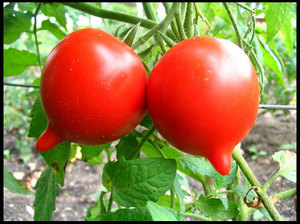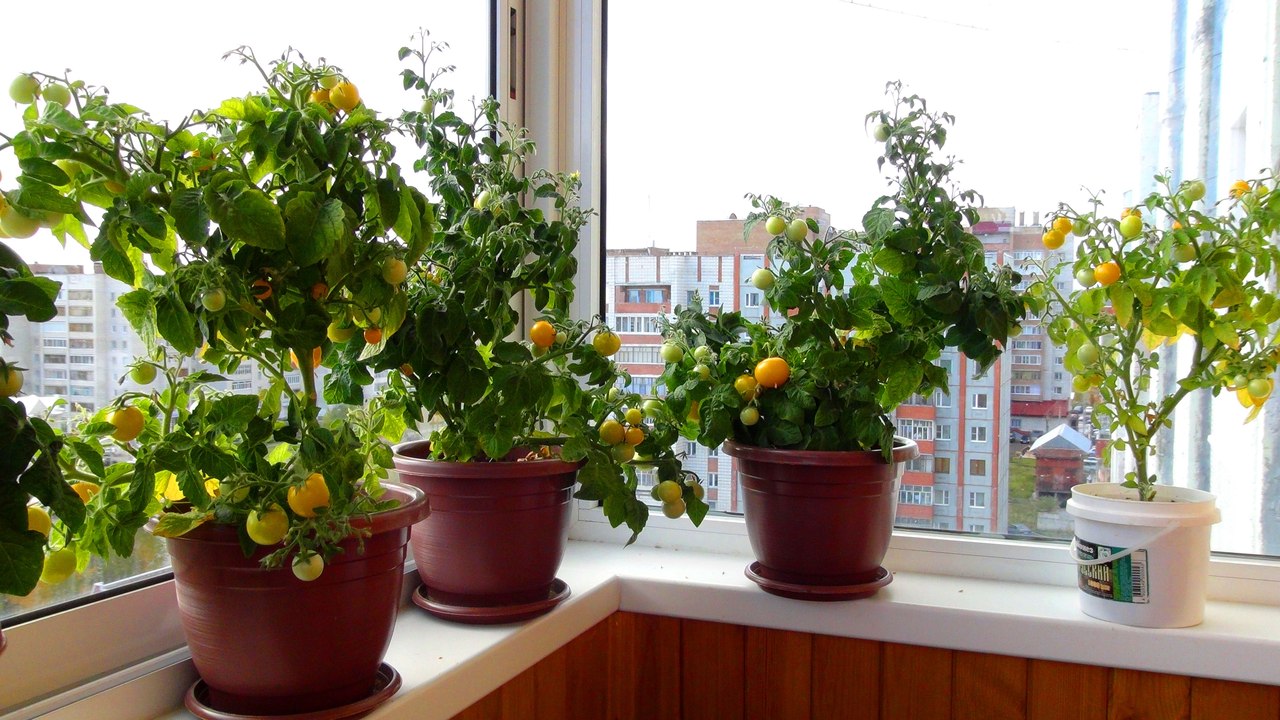There are a large number of a wide variety of varieties of red vegetables on sale, and often in the description on the bag you can find such a concept as a determinant or indeterminate type of plant. What it is? For many novice gardeners, these terms are not entirely clear and, when choosing a new variety, they do not always take this into account.
As a result, a sown unknown tomato can give a strong thickening or, conversely, an almost empty area. This has the most negative effect on the future harvest. Therefore, it is necessary to figure out how the types of plants differ from each other?
What is a determinant tomato variety
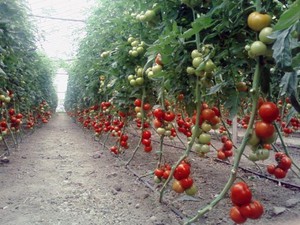 The term “determinant” means “having limited growth”, and “indeterminate” means “unlimited growth”.
The term “determinant” means “having limited growth”, and “indeterminate” means “unlimited growth”.
What are the characteristics of tomatoes belonging to the first type? At the end of the shoot, they have an ovary with fruits, which in the future stops growing... The fruit continues to grow from the strongest stepson in the leaf axil below.
The other type of tomato does not have such a limitation, the central top of them continues to grow without limitation with a flower brush.
The difference between one and the other
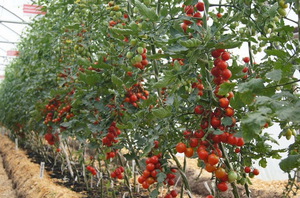 It is easy to distinguish these tomatoes from each other even before they have flowers and fruits. Four days after the shoots appear, the cotyledonous knee begins to expand, and by its length it is already possible to indirectly judge which variety will grow in the future.
It is easy to distinguish these tomatoes from each other even before they have flowers and fruits. Four days after the shoots appear, the cotyledonous knee begins to expand, and by its length it is already possible to indirectly judge which variety will grow in the future.
In indeterminate varieties, it is 3-5 cm, and in others, 1-3 cm. However, if there is not enough light, such a seedling begins to stretch strongly and in this case it is difficult to determine what the bush will be.
As soon as the seedlings have the first flower cluster, it is already enough easy to identify the variety future bush. In indeterminate types, the first brush is formed after 8-9 true leaves and above, and in determinant types, after 6-7 leaves and below.
If the tomato has been planted for a long time, has grown well and has several tied clusters with fruits, then it is already difficult to determine the number of leaves before the first ovary, because the seedlings are often deepened and part of the stem may remain underground.
A flower cluster in an indeterminate variety is laid after 3 leaves. Other types between brushes always have less than three real leaves. In addition, this variety always has a shoot ending in an ovary.
Views
This tomato variety has four varieties with their own characteristic features:
 Semi-determinant - tomatoes of this sort stop their growth after they have formed 10-12 flower brushes, the laying of which occurs every two true leaves, but there may be gaps with three leaves. The first flower cluster begins to form after 7-8 leaves.
Semi-determinant - tomatoes of this sort stop their growth after they have formed 10-12 flower brushes, the laying of which occurs every two true leaves, but there may be gaps with three leaves. The first flower cluster begins to form after 7-8 leaves.- Determinant - the formation of flower brushes in such tomatoes occurs every three leaves, but only if 5-6 of them have grown.
- Superdeterminate - this type is considered early ripening, and flower brushes begin to form after 1-2 leaves, and as soon as 4 or 5 of them are formed, an shoot appears, limiting the growth of a tomato with a peduncle.
- Super-super-determinant - mainly ultra-early maturing and super-dwarf varieties. They usually have 2-3 flower clusters in a row without any gaps from the leaves.Shoot growth is limited after 3-4 peduncles appear. The appearance of the first brush occurs after the fifth true leaf.
Advantages and disadvantages
The positive aspects of this tomato variety include:
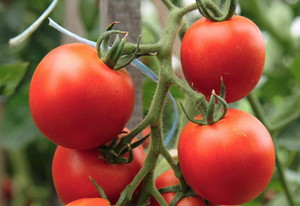 Early maturity, because the flower cluster is formed through fewer leaves than in indeterminate varieties, so the first fruit ripens early enough.
Early maturity, because the flower cluster is formed through fewer leaves than in indeterminate varieties, so the first fruit ripens early enough.- High early yield, since the ovaries are laid through a smaller number of leaves and there are a lot of them on one meter of the stem, therefore, the harvest is rich.
- A friendly return of the crop, because several brushes can be tied at the same time.
Negative points:
- the total yield is small, since the growth of the bush is limited by the brushes, it can be completely completed, the plant stops growing in height and new ovaries stop forming;
- due to the fact that brushes are formed quite often, a lot of mineral nutrition is needed to form a crop;
- since the growth of the bush is limited by the peduncle, so as not to overload the plant with a large number of ovaries, it is necessary to remove the stepsons;
- due to the fact that the bush is quite heavily loaded with ovaries, this reduces its resistance to various infections.
Care
Care includes compliance with the following requirements:
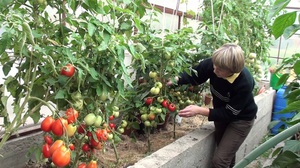 hilling regularity;
hilling regularity;- correct pinching process;
- plucking stems to stimulate the branching process;
- top dressing with various fertilizers, carried out before the hilling process;
- watering as needed;
- control of pests and various diseases.
Tying and pinching carry out all types of varieties. If you do not get rid of the stepsons that form in the axils of tomato leaves in a timely manner, the fruits in this case will ripen for quite a long time, and the growth of plants will noticeably stop.
Stepsons should be removed regularly so that the bush grows well. It is rarely necessary to water the plants, but systematically and abundantly enough... The soil should dry thoroughly before the next watering.
Water droplets should not fall on the leaves, otherwise a fungal disease such as late blight may develop, leading to blackening of the plant and its death. Watering tomatoes is necessary at the root, using a drip irrigation system.
Protecting tomatoes from pests and diseases
To protect the plant from diseases and fungal infections, it should be treated with special preparations, such as Tattu, Infinito, Alett, Ridomil Gold.
A very dangerous disease is apical rot, which causes blackening of the tops of the stem. In this case, the shoots sprayed with calcium nitrate during planting seedlings.
The most dangerous pests are the Colorado potato beetle, aphid, winter scoop, against which the following drugs are used: “Fitoverm "," Aktovit "," Confidor". Aphids can also be fought in the following way: they send a strong stream of water to the place of accumulation of pests and rub the leaves with ash.
The best determinant varieties
What varieties of tomatoes can give a good harvest? The most popular are:
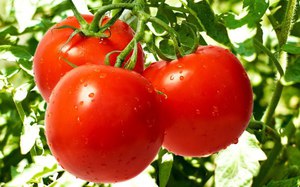 "Dubok" is a tasty and fleshy fruit with a bright red color. It ripens early and is resistant to diseases such as late blight. Its taste is pleasant and sweet.
"Dubok" is a tasty and fleshy fruit with a bright red color. It ripens early and is resistant to diseases such as late blight. Its taste is pleasant and sweet.- "Yamal" - has a wonderful taste, ripens early and is well stored.
- "Honey cream" - the fruits of this variety are plum-shaped. In addition to their excellent taste, they are well suited for preservation, ripen early and have a long shelf life.
- "Grotto" is an ultra-early ripening variety with a wonderful round-shaped taste. The fruits weigh a little - 50−80 years.
Thus, we found out what a determinant tomato variety is and how it differs from another kind. These tomatoes have their own positive and negative sides... They are grown both in greenhouses and in the open field.
The taste of this variety is simply wonderful, and the fruits are distinguished by their early maturity. It is beneficial to cultivate them from an economic point of view, since they do not require a lot of space and they give a good harvest quickly.

